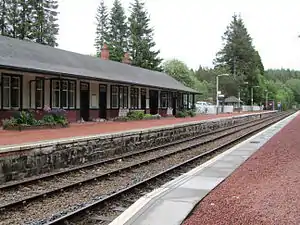Tulloch railway station
Tulloch railway station is a rural railway station in the remote Tulloch area of the Highland region of Scotland. This station is on the West Highland Line, 105 miles (169 km) north of Glasgow Queen Street.
 Tulloch station, looking east (towards Glasgow) | |
| Location | Tulloch, Highland Scotland |
| Coordinates | 56.8841°N 4.7012°W |
| Grid reference | NN354802 |
| Managed by | Abellio ScotRail |
| Platforms | 2 |
| Other information | |
| Station code | TUL |
| History | |
| Original company | West Highland Railway |
| Pre-grouping | North British Railway |
| Post-grouping | LNER |
| Key dates | |
| 7 August 1894 | Opened as Inverlair |
| 1 January 1895 | Renamed as Tulloch |
| Passengers | |
| 2015/16 | |
| 2016/17 | |
| 2017/18 | |
| 2018/19 | |
| 2019/20 | |
| Notes | |
Passenger statistics from the Office of Rail and Road | |
With 2,148 entries and exits in the 2018/19 period, Tulloch is the least busy station in Scotland with direct London services, and the least busy station along the line from Glasgow Queen Street to Fort William.
History
When the railway opened on 7 August 1894 the station was named Inverlair, after the nearby Inverlair Lodge. It was renamed Tulloch on 1 January 1895.[2]
The station was laid out with two platforms, one on either side of a crossing loop. There are sidings on the north side of the station.[3]
The station buildings are now used as a hostel.[4] The station was host to a LNER camping coach from 1935 to 1939.[5]
During the construction of the Lochaber hydroelectric scheme in the 1930s a small halt was located at Fersit, a short distance south on the line towards Corrour.
Signalling
The signal box, which had 15 levers, was situated on the Up platform. From the time of its opening in 1894, the West Highland Railway was worked throughout by the electric token system.
The semaphore signals were removed on 23 February 1986 in preparation for the introduction of Radio Electronic Token Block (RETB) by British Rail.
The RETB system was commissioned between Upper Tyndrum and Fort William Junction on 29 May 1988. This resulted in the closure of Tulloch signal box and others on that part of the line. The RETB is controlled from a Signalling Centre at Banavie railway station.
The Train Protection & Warning System was installed in 2003.
Services
2016 services
Monday to Saturday, northbound, Tulloch has three services to Mallaig and one service to Fort William (the Highland Caledonian Sleeper). Southbound, there are three services to Glasgow Queen Street and one service to London Euston (Highland Caledonian Sleeper, Saturdays excepted). On Sundays, there is just one service northbound to Mallaig (plus a second from May to late October), one service southbound to Glasgow Queen Street (two in summer) and one service (Highland Caledonian Sleeper) to London Euston.[6] The sleeper also carries seated coaches and can thus be used by regular travellers to both Glasgow and Edinburgh Waverley.
| Preceding station | Following station | |||
|---|---|---|---|---|
| Corrour | Abellio ScotRail West Highland Line |
Roy Bridge | ||
| Caledonian Sleeper Highland Caledonian Sleeper |
||||
| Historical railways | ||||
| Fersit Halt Line open; station closed |
North British Railway West Highland Railway |
Roy Bridge Line and station open | ||
References
Notes
- Brailsford 2017, Gaelic/English Station Index.
- Quick 2019, p. 403.
- "Tulloch station on OS Six-inch map Inverness-shire - Mainland Sheet CXLII (includes: Kilmonivaig)". National Library of Scotland. 1904. Retrieved 9 June 2020.
- Tulloch Station Lodge
- McRae 1997, p. 11.
- GB eNRT May 2016 Edition, Table 227 (Network Rail)
Sources
- Brailsford, Martyn, ed. (December 2017) [1987]. Railway Track Diagrams 1: Scotland & Isle of Man (6th ed.). Frome: Trackmaps. ISBN 978-0-9549866-9-8.
- McRae, Andrew (1997). British Railway Camping Coach Holidays: The 1930s & British Railways (London Midland Region). Scenes from the Past: 30 (Part One). Foxline. ISBN 1-870119-48-7.
- Quick, Michael (2019) [2001]. Railway passenger stations in Great Britain: a chronology (PDF) (5th ed.). Railway and Canal Historical Society.
Further reading
| Wikimedia Commons has media related to Tulloch railway station. |
- Butt, R. V. J. (1995). The Directory of Railway Stations: details every public and private passenger station, halt, platform and stopping place, past and present (1st ed.). Sparkford: Patrick Stephens Ltd. ISBN 978-1-85260-508-7. OCLC 60251199.
- Jowett, Alan (March 1989). Jowett's Railway Atlas of Great Britain and Ireland: From Pre-Grouping to the Present Day (1st ed.). Sparkford: Patrick Stephens Ltd. ISBN 978-1-85260-086-0. OCLC 22311137.
- "Tulloch station restored as a quality bunkhouse". RAIL. No. 333. EMAP Apex Publications. 17–30 June 1998. p. 16. ISSN 0953-4563. OCLC 49953699.